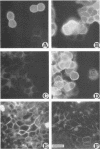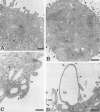Abstract
The gastrointestinal tract is considered to be a major route of infection for human immunodeficiency virus (HIV). Infection of human colon epithelial cells by HIV is not blocked by anti-CD4 antibodies known to block infection of lymphoid cells (J. Fantini, N. Yahi, and J. C. Chermann, Proc. Natl. Acad. Sci. USA 88:9297-9301, 1991), suggesting the presence of an alternate receptor for HIV on these cells. In this report, we show that (i) a monoclonal antibody specifically directed against galactosyl ceramide inhibited the infection of HT29 cells by two markedly different strains of HIV-1, as assessed by polymerase chain reaction amplification and reverse transcriptase assay; (ii) this antibody strongly labeled the surface of HT29 cells by immunofluorescence and electron microscopic immunolocalization; (iii) the labeling was preferentially but not totally restricted to the basolateral membrane domain of differentiated colonic cells, in agreement with the ability of HIV to infect both the apical and basolateral surfaces of these epithelial cells; and (iv) in thin-layer chromatography-immunostaining experiments with neutral glycolipids prepared from HT29 cells, the antibody specifically reacted with a ceramide monoglycoside fraction corresponding to galactosyl ceramide. We did not detect this glycolipid in lymphoid cells, and anti-galactosyl ceramide antibodies consistently failed to inhibit HIV infection of these cells. These data suggest that galactosyl ceramide (or a derivative) is an essential component of the receptor for HIV on the surface of HT29 cells.
Full text
PDF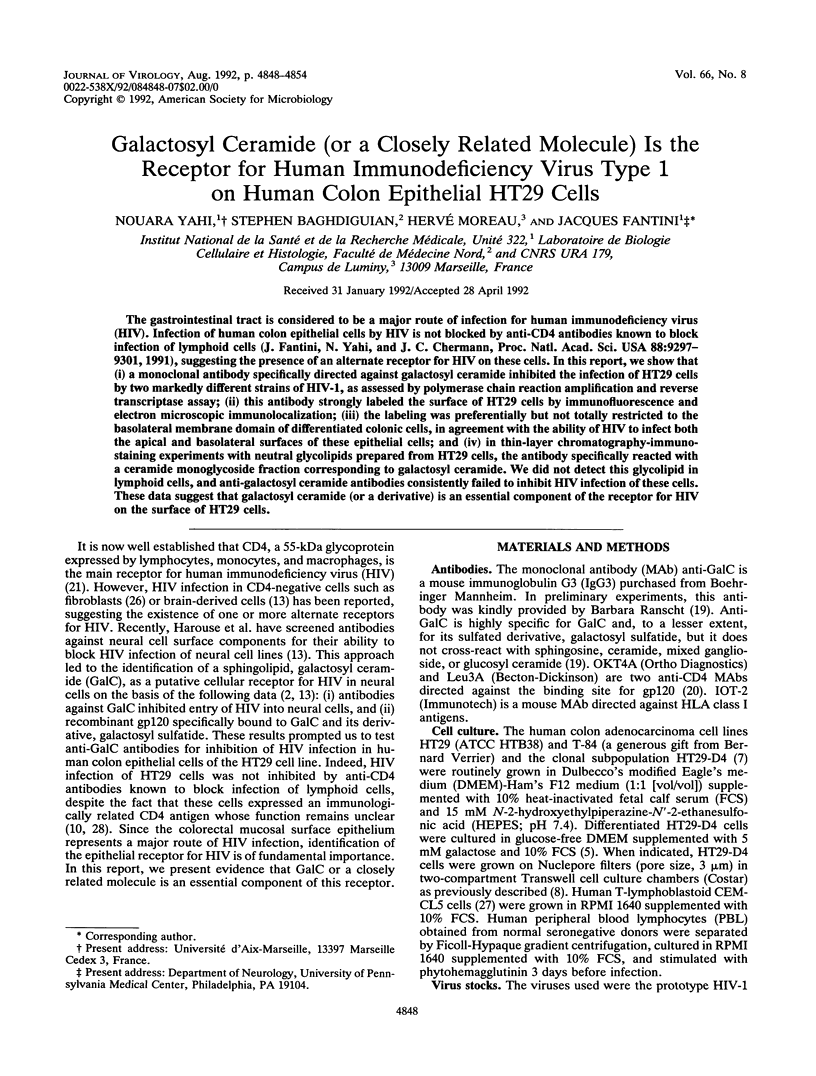

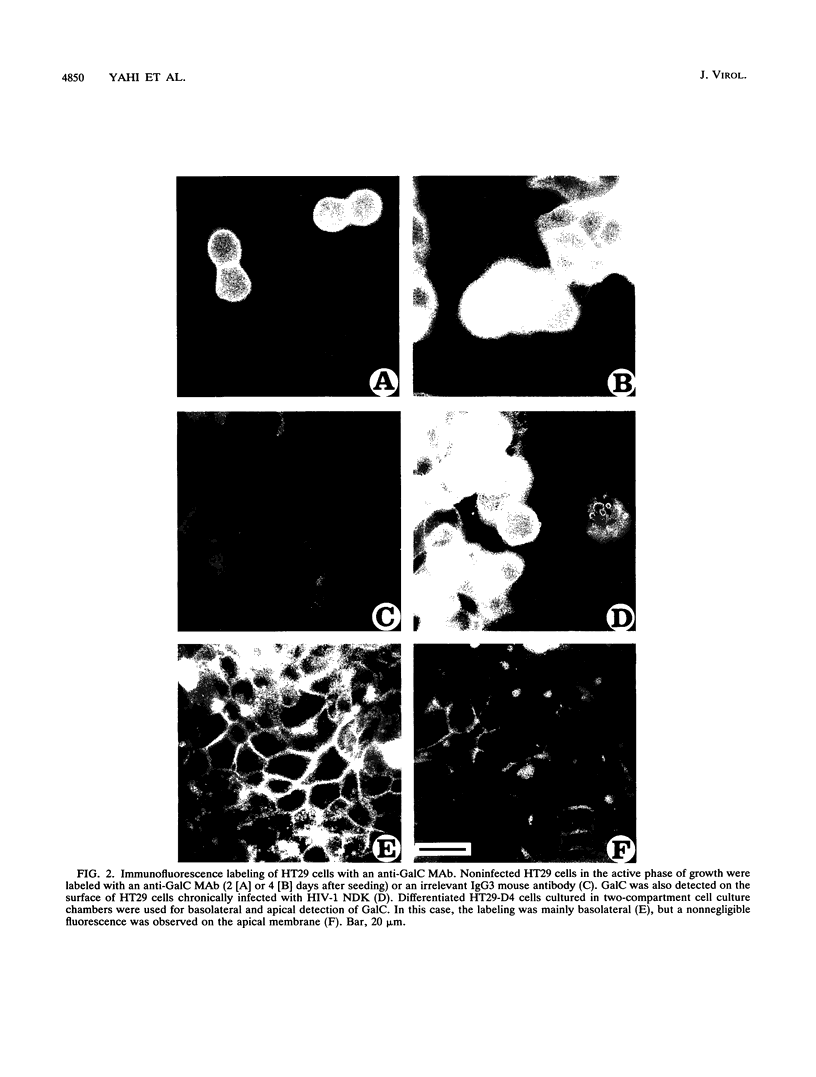
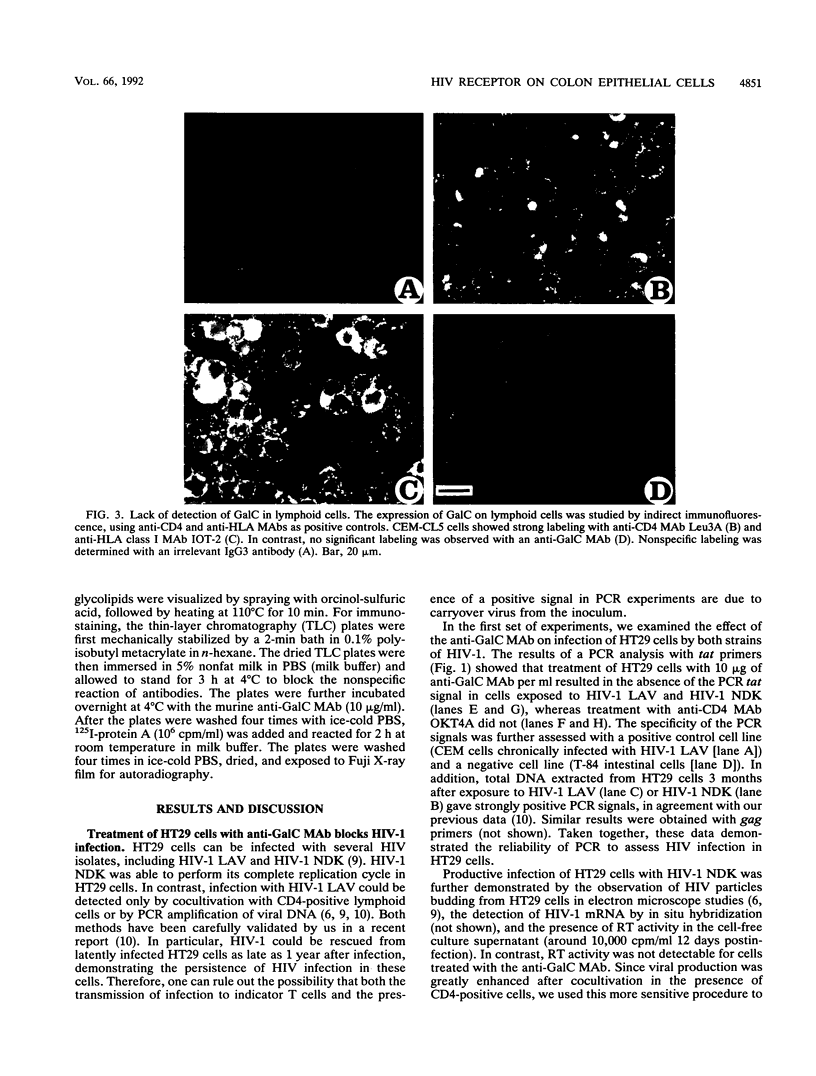
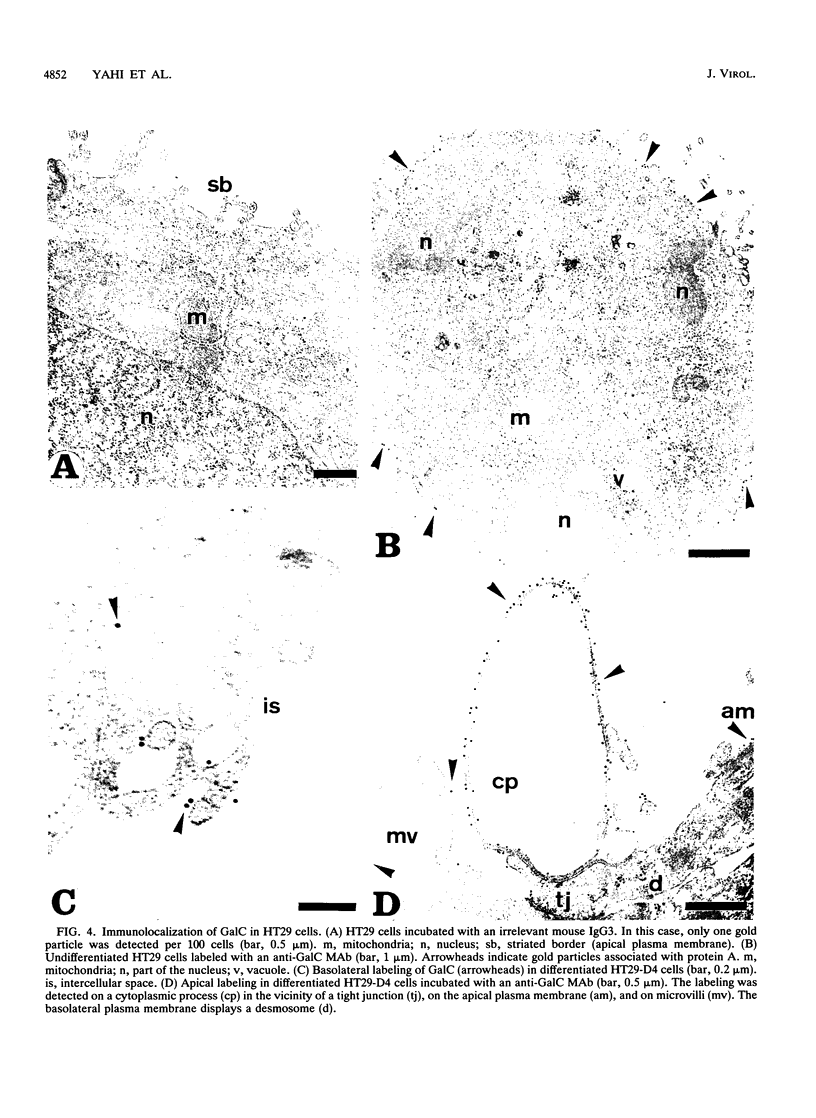
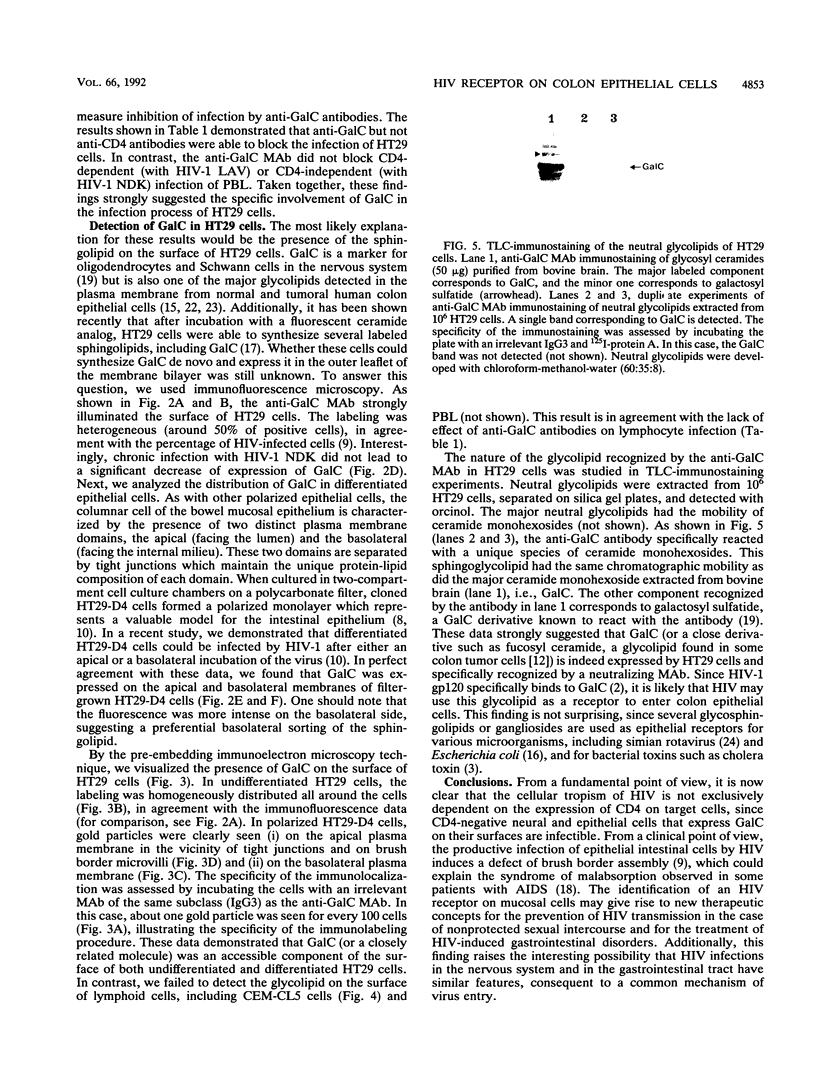
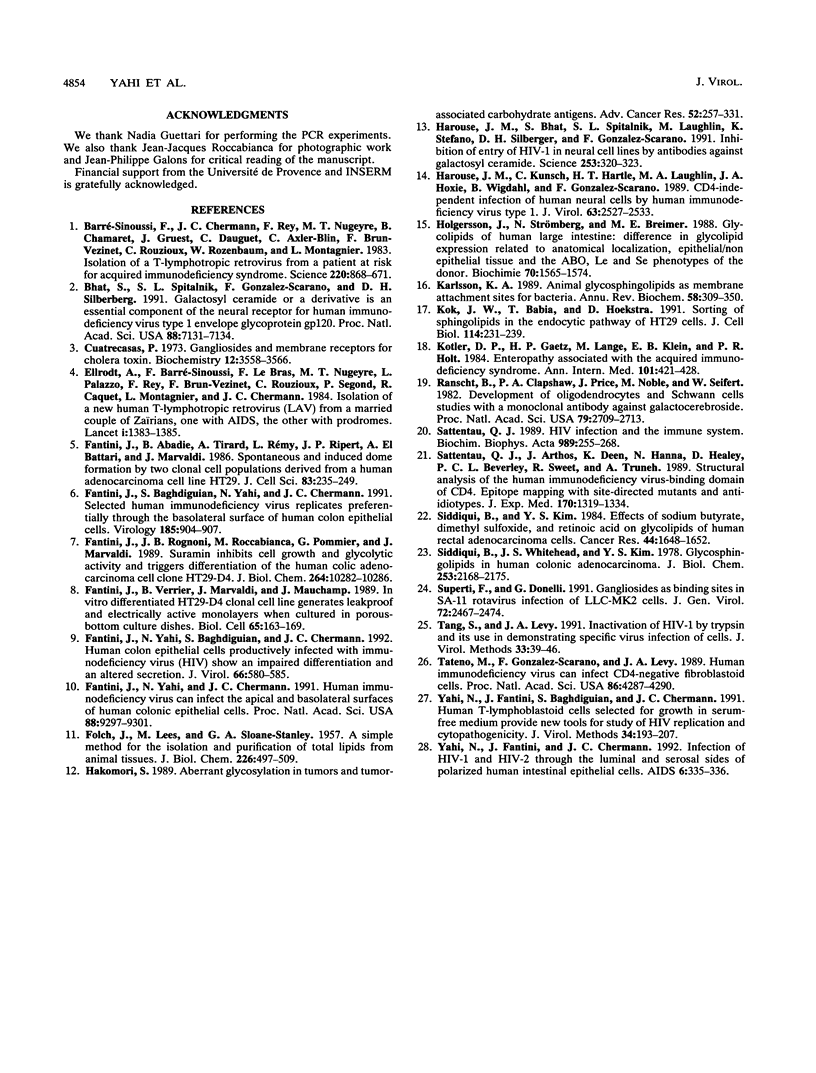
Images in this article
Selected References
These references are in PubMed. This may not be the complete list of references from this article.
- Barré-Sinoussi F., Chermann J. C., Rey F., Nugeyre M. T., Chamaret S., Gruest J., Dauguet C., Axler-Blin C., Vézinet-Brun F., Rouzioux C. Isolation of a T-lymphotropic retrovirus from a patient at risk for acquired immune deficiency syndrome (AIDS). Science. 1983 May 20;220(4599):868–871. doi: 10.1126/science.6189183. [DOI] [PubMed] [Google Scholar]
- Bhat S., Spitalnik S. L., Gonzalez-Scarano F., Silberberg D. H. Galactosyl ceramide or a derivative is an essential component of the neural receptor for human immunodeficiency virus type 1 envelope glycoprotein gp120. Proc Natl Acad Sci U S A. 1991 Aug 15;88(16):7131–7134. doi: 10.1073/pnas.88.16.7131. [DOI] [PMC free article] [PubMed] [Google Scholar]
- Cuatrecasas P. Gangliosides and membrane receptors for cholera toxin. Biochemistry. 1973 Aug 28;12(18):3558–3566. doi: 10.1021/bi00742a032. [DOI] [PubMed] [Google Scholar]
- Ellrodt A., Barre-Sinoussi F., Le Bras P., Nugeyre M. T., Palazzo L., Rey F., Brun-Vezinet F., Rouzioux C., Segond P., Caquet R. Isolation of human T-lymphotropic retrovirus (LAV) from Zairian married couple, one with AIDS, one with prodromes. Lancet. 1984 Jun 23;1(8391):1383–1385. doi: 10.1016/s0140-6736(84)91877-4. [DOI] [PubMed] [Google Scholar]
- FOLCH J., LEES M., SLOANE STANLEY G. H. A simple method for the isolation and purification of total lipides from animal tissues. J Biol Chem. 1957 May;226(1):497–509. [PubMed] [Google Scholar]
- Fantini J., Abadie B., Tirard A., Remy L., Ripert J. P., el Battari A., Marvaldi J. Spontaneous and induced dome formation by two clonal cell populations derived from a human adenocarcinoma cell line, HT29. J Cell Sci. 1986 Jul;83:235–249. doi: 10.1242/jcs.83.1.235. [DOI] [PubMed] [Google Scholar]
- Fantini J., Baghdiguian S., Yahi N., Chermann J. C. Selected human immunodeficiency virus replicates preferentially through the basolateral surface of differentiated human colon epithelial cells. Virology. 1991 Dec;185(2):904–907. doi: 10.1016/0042-6822(91)90570-2. [DOI] [PubMed] [Google Scholar]
- Fantini J., Rognoni J. B., Roccabianca M., Pommier G., Marvaldi J. Suramin inhibits cell growth and glycolytic activity and triggers differentiation of human colic adenocarcinoma cell clone HT29-D4. J Biol Chem. 1989 Jun 15;264(17):10282–10286. [PubMed] [Google Scholar]
- Fantini J., Verrier B., Marvaldi J., Mauchamp J. In vitro differentiated HT 29-D4 clonal cell line generates leakproof and electrically active monolayers when cultured in porous-bottom culture dishes. Biol Cell. 1989;65(2):163–169. [PubMed] [Google Scholar]
- Fantini J., Yahi N., Baghdiguian S., Chermann J. C. Human colon epithelial cells productively infected with human immunodeficiency virus show impaired differentiation and altered secretion. J Virol. 1992 Jan;66(1):580–585. doi: 10.1128/jvi.66.1.580-585.1992. [DOI] [PMC free article] [PubMed] [Google Scholar]
- Fantini J., Yahi N., Chermann J. C. Human immunodeficiency virus can infect the apical and basolateral surfaces of human colonic epithelial cells. Proc Natl Acad Sci U S A. 1991 Oct 15;88(20):9297–9301. doi: 10.1073/pnas.88.20.9297. [DOI] [PMC free article] [PubMed] [Google Scholar]
- Hakomori S. Aberrant glycosylation in tumors and tumor-associated carbohydrate antigens. Adv Cancer Res. 1989;52:257–331. doi: 10.1016/s0065-230x(08)60215-8. [DOI] [PubMed] [Google Scholar]
- Harouse J. M., Bhat S., Spitalnik S. L., Laughlin M., Stefano K., Silberberg D. H., Gonzalez-Scarano F. Inhibition of entry of HIV-1 in neural cell lines by antibodies against galactosyl ceramide. Science. 1991 Jul 19;253(5017):320–323. doi: 10.1126/science.1857969. [DOI] [PubMed] [Google Scholar]
- Harouse J. M., Kunsch C., Hartle H. T., Laughlin M. A., Hoxie J. A., Wigdahl B., Gonzalez-Scarano F. CD4-independent infection of human neural cells by human immunodeficiency virus type 1. J Virol. 1989 Jun;63(6):2527–2533. doi: 10.1128/jvi.63.6.2527-2533.1989. [DOI] [PMC free article] [PubMed] [Google Scholar]
- Holgersson J., Strömberg N., Breimer M. E. Glycolipids of human large intestine: difference in glycolipid expression related to anatomical localization, epithelial/non-epithelial tissue and the ABO, Le and Se phenotypes of the donors. Biochimie. 1988 Nov;70(11):1565–1574. doi: 10.1016/0300-9084(88)90292-1. [DOI] [PubMed] [Google Scholar]
- Karlsson K. A. Animal glycosphingolipids as membrane attachment sites for bacteria. Annu Rev Biochem. 1989;58:309–350. doi: 10.1146/annurev.bi.58.070189.001521. [DOI] [PubMed] [Google Scholar]
- Kok J. W., Babia T., Hoekstra D. Sorting of sphingolipids in the endocytic pathway of HT29 cells. J Cell Biol. 1991 Jul;114(2):231–239. doi: 10.1083/jcb.114.2.231. [DOI] [PMC free article] [PubMed] [Google Scholar]
- Kotler D. P., Gaetz H. P., Lange M., Klein E. B., Holt P. R. Enteropathy associated with the acquired immunodeficiency syndrome. Ann Intern Med. 1984 Oct;101(4):421–428. doi: 10.7326/0003-4819-101-4-421. [DOI] [PubMed] [Google Scholar]
- Ranscht B., Clapshaw P. A., Price J., Noble M., Seifert W. Development of oligodendrocytes and Schwann cells studied with a monoclonal antibody against galactocerebroside. Proc Natl Acad Sci U S A. 1982 Apr;79(8):2709–2713. doi: 10.1073/pnas.79.8.2709. [DOI] [PMC free article] [PubMed] [Google Scholar]
- Sattentau Q. J., Arthos J., Deen K., Hanna N., Healey D., Beverley P. C., Sweet R., Truneh A. Structural analysis of the human immunodeficiency virus-binding domain of CD4. Epitope mapping with site-directed mutants and anti-idiotypes. J Exp Med. 1989 Oct 1;170(4):1319–1334. doi: 10.1084/jem.170.4.1319. [DOI] [PMC free article] [PubMed] [Google Scholar]
- Sattentau Q. J. HIV infection and the immune system. Biochim Biophys Acta. 1989 Dec 27;989(3):255–268. [PubMed] [Google Scholar]
- Siddiqui B., Kim Y. S. Effects of sodium butyrate, dimethyl sulfoxide, and retinoic acid on glycolipids of human rectal adenocarcinoma cells. Cancer Res. 1984 Apr;44(4):1648–1652. [PubMed] [Google Scholar]
- Siddiqui B., Whitehead J. S., Kim Y. S. Glycosphingolipids in human colonic adenocarcinoma. J Biol Chem. 1978 Apr 10;253(7):2168–2175. [PubMed] [Google Scholar]
- Superti F., Donelli G. Gangliosides as binding sites in SA-11 rotavirus infection of LLC-MK2 cells. J Gen Virol. 1991 Oct;72(Pt 10):2467–2474. doi: 10.1099/0022-1317-72-10-2467. [DOI] [PubMed] [Google Scholar]
- Tang S. B., Levy J. A. Inactivation of HIV-1 by trypsin and its use in demonstrating specific virus infection of cells. J Virol Methods. 1991 Jun;33(1-2):39–46. doi: 10.1016/0166-0934(91)90005-k. [DOI] [PubMed] [Google Scholar]
- Tateno M., Gonzalez-Scarano F., Levy J. A. Human immunodeficiency virus can infect CD4-negative human fibroblastoid cells. Proc Natl Acad Sci U S A. 1989 Jun;86(11):4287–4290. doi: 10.1073/pnas.86.11.4287. [DOI] [PMC free article] [PubMed] [Google Scholar]
- Yahi N., Fantini J., Baghdiguian S., Chermann J. C. Human T-lymphoblastoid cells selected for growth in serum-free medium provide new tools for study of HIV replication and cytopathogenicity. J Virol Methods. 1991 Sep-Oct;34(2):193–207. doi: 10.1016/0166-0934(91)90099-l. [DOI] [PubMed] [Google Scholar]
- Yahi N., Fantini J., Chermann J. C. Infection of HIV-1 and HIV-2 through the luminal and serosal sides of polarized human intestinal epithelial cells. AIDS. 1992 Mar;6(3):335–336. [PubMed] [Google Scholar]




